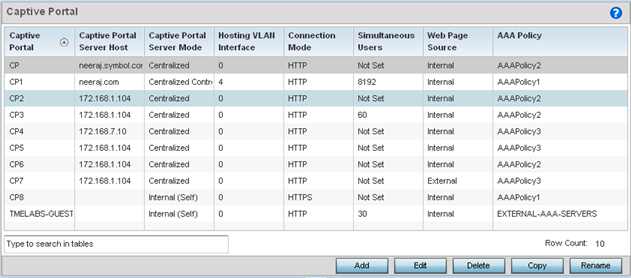To configure a captive portal policy:
Select Configuration > Services.
The upper, left-hand, side of the user interface displays a Services menu where Captive Portal, DHCP and RADIUS configuration options can be selected.
Select Captive Portals.
The Captive Portal screen displays existing policies. New policies can be created, existing policies can be modified or existing policies deleted.

Refer to the following captive portal policy parameters to determine whether a new policy requires creation, or an existing policy requires edit or deletion:
|
Captive Portal Policy |
Displays the name assigned to the captive portal policy when initially created. A policy name cannot be modified as part of the edit process. |
|
Captive Portal Server |
Lists the IP address (non DNS hostname) of the external (fixed) server validating user permissions for the listed captive portal policy. This item remains empty if the captive portal is hosted locally. |
|
Captive Portal Server Mode |
Lists each policy's hosting mode as either Internal (Self) or External (Fixed). If the mode is Internal (Self), the controller or access point is maintaining the captive portal internally, while External (Fixed) means the captive portal is being hosted on an external server resource. |
|
Hosting VLAN Interface |
Lists the VLAN (from 1 - 4,094) a client utilizes for controller or service platform interoperation when the Captive Portal Server Mode is set to Centralized Controller. |
|
Connection Mode |
Lists each policy's connection mode as either HTTP or HTTPS. Both HTTP and HTTPS use the same Uniform Resource Identifier (URI), so requesting clients can be identified. However, the use of HTTPS is recommended, as it affords transmissions some measure of data protection HTTP cannot provide. |
|
Simultaneous Users |
Displays the number of users permitted at one time for each listed captive portal. A captive portal can support from 0-8192 users simultaneously. |
|
Web Page Source |
Displays whether the captive portal HTML pages are maintained Internally, Externally (on an external system you define) or are Advanced pages maintained and customized by the network administrator. Internal is the default setting. |
|
AAA Policy |
Lists each AAA policy used to authorize captive portal access requests. When a captive portal policy is created or modified, a AAA policy must be defined and applied to effectively authorize, authenticate and account user requests for captive portal access. |